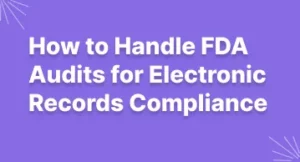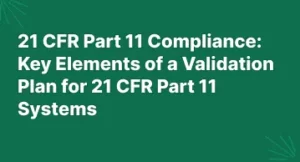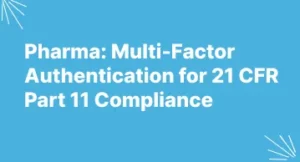Unraveling Regulations: 21 CFR Part 11 vs EU Annex 11
Introduction:
Understanding the Difference Between 21 CFR Part 11 and EU Annex 11
In today’s digital age, organizations must be equipped to manage electronic records in a consistent, secure manner. In order to achieve this objective, there are two key international regulations that become important for an organization to understand and abide by: 21 CFR Part 11 and EU Annex 11. It is essential to know the difference between the two regulations in order to correctly implement them, maintain compliance, and prevent any legal or financial repercussions.
21 CFR Part 11 outlines requirements for validation, integrity, and accuracy of electronic records. It is primarily found in the United States and sets forth guidelines for maintaining and monitoring the accuracy, validity, security, and privacy of electronic records. Meanwhile, EU Annex 11 focuses on Good Manufacturing Practices (GMPs) in regards to electronic record-keeping, including topics such as security, user access, and system validation.
Below, we will dive into the specifics of these two key regulations and explore how they differ, what areas they share common ground, and what organizations need to do in order to comply with both.
Explaining 21 CFR Part 11 Legislation
The 21 CFR Part 11 legislation defines regulations that cover the validation, integrity and accuracy of electronic records. This regulation applies to all organizations that must Produce, Process, Store or Archive data electronically. The regulation requires those involved in the process to ensure that their systems are secure and any data stored is well maintained and stays accurate throughout. 21 CFR Part 11 also sets out strict requirements for electronic signatures on documents, to protect the integrity of records.
As part of meeting the regulations, organizations must assess and record any risks associated with their data management processes. They must then employ appropriate measures to limit the likelihood of such risks occurring. There must also be processes in place to monitor performance and ensure accuracy of the data. It is essential that these processes are documented and reviewed periodically to ensure they remain valid and sufficient.
Explain EU Annex 11 Regulations on GMP Record Keeping
EU Annex 11 requires Good Manufacturing Practices (GMPs) be followed in regards to the keeping of digital records. GMPs are guidelines designed to ensure quality through all stages of production, from start to finish. This Annex outlines requirements related to validation, accuracy and integrity of electronic records.
The regulation is designed to ensure that pharmaceutical products meet quality and safety standards set by European Union law, while also offering a framework for healthcare and medical device manufacturers in the EU. The Annex covers a range of topics related to the keeping of records, including:
- The type of records that must be maintained;
- The manner in which records shall be kept;
- Security measures required to protect records;
- Training requirements for personnel handling record-keeping;
- The format in which records shall be stored.
By complying with EU Annex 11, organizations are provided assurance that their products meet necessary safety and quality standards, and that their data has undergone proper validation processes. This framework helps ensure that all operations related to the production of pharmaceuticals and medical devices remain safe, and records will be secure if needed at a later date.
Comparing Practical Differences between 21 CFR Part 11 and EU Annex 11
When it comes to 21 CFR Part 11 and EU Annex 11, there are a few differences between the two regulations that should be highlighted. The biggest difference lies in the scope and scale of each regulation. 21 CFR Part 11 focuses primarily on data integrity, while EU Annex 11 emphasizes good manufacturing practices (GMPs). This means any record keeping and documentation related to pharmaceutical products must adhere to standards laid out in EU Annex 11.
Another major difference has to do with the requirements for electronic documentation. 21 CFR Part 11 speaks directly to computer systems, specifically regarding validation and verification around recordings of electronic transactions. EU Annex 11, on the other hand, does not discuss electronic systems at all. Instead, it requires that paper records are kept in well-organized files and are readily available for review upon request.
It is also worth noting that 21 CFR Part 11 applies to FDA-regulated industries, while EU Annex 11 is stricter with the inclusion of GMP standards. Additionally, 21 CFR Part 11 stipulates that data must not be changed or destroyed without leaving an audit trail, whereas EU Annex 11 does not lay out similar requirements. Finally, the way companies handle user access to different systems will be dictated by 21 CFR Part 11, while EU Annex 11 does not explicitly address such matters.
Common Points of Agreement Between 21 CFR Part 11 and EU Annex 11
Both the 21 CFR Part 11 and EU Annex 11 regulations have certain points that are in agreement. While they have some distinct differences and may be implemented differently, both regulations work towards the goal of providing safe and secure electronic record-keeping. Here are some of the common elements that are covered by both regulations:
- Both regulations require that electronic records be attributable to one or more persons.
- Both regulations ensure the integrity of electronic records.
- Both regulations include controls on the preservation and storage of electronic records.
- Both regulations cover training requirements for personnel.
- Both regulations require the implementation of common audit trails.
- Both regulations demand continual monitoring of system and data accuracy.
Overall, the agreement between 21 CFR Part 11 and EU Annex 11 provides a solid foundation for the accuracy and security of electronic records. By following both sets of regulations, organizations can ensure that their electronic records are kept in compliance with both regulations.
Operating 21 CFR Part 11 and EU Annex 11 Together
It is possible for organizations to use both 21 CFR Part 11 and EU Annex 11 together within the same organization. In order to do this, organizations must take into account how the two regulations intersect and how to incorporate them into any existing quality and compliance system.
The best way to do this is by creating Standard Operating Procedures (SOPs) that address each regulation separately and then combine them to create a unified set of protocols for electronic records and data integrity. When this has been accomplished, the organization can begin to see the value that a combined approach can bring.
21 CFR Part 11 requires organizations to have effective processes for validation, integrity, and accuracy of their electronic records. Meanwhile, EU Annex 11 outlines Good Manufacturing Practices (GMPs) for electronic recordkeeping. By understanding the differences between the two regulations, organizations are better able to comply with both regulations, and in turn, gain the full benefits from each.
Legal Implications
When it comes to managing these two regulations, it is important to consider the legal implications that each of them have. 21 CFR Part 11 stipulates that firms must take reasonable steps to ensure that electronic records are accurate, secure, and have integrity. Violations of this regulation can result in fines up to $10,000 and criminal charges for those who knowingly create or manipulate the records. EU Annex 11, on the other hand, requires firms to have processes in place that ensure that automated records are accurate, secure, and complete. Failing to adhere to this regulation can lead to potential regulatory sanctions and financial penalties.
Compliance with 21 CFR Part 11 and EU Annex 11
When it comes to compliance with 21 CFR Part 11 and EU Annex 11, it’s important to understand that there are some differences between them. 21 CFR Part 11 outlines requirements for validation, integrity, and accuracy of electronic records, while EU Annex 11 is focused more on Good Manufacturing Practices (GMPs) in regards to electronic record-keeping. Those who must meet the requirements of both regulations must do so in parallel, understanding how both processes work together.
In order to ensure compliance with both 21 CFR Part 11 and EU Annex 11, organizations should ensure that they have clear and comprehensive policies and procedures in place for both. This means having secure data storage systems, rigid standards in place for changing processes, and well-defined definitions for roles and responsibilities for anyone handling regulated data. Additionally, regular auditing should be performed to ensure that all mandated requirements are being met.
To make sure that your organization is meeting both 21 CFR Part 11 and EU Annex 11 standards, it’s best to seek help from experts in the field. Through their assistance, you can ensure that your policies and processes are compliant and up to date with the latest laws and regulations.
Best Practices for Effective SOPs
To stay compliant with both 21 CFR Part 11 and EU Annex 11, it is important to create effective Standard Operating Procedures (SOPs). These documents help organizations maintain order and accountability when it comes to the implementation of their electronic records regulations. Here are some best practices to follow when creating an SOP to address both 21 CFR Part 11 and EU Annex 11:
- Ensure that all components of a record-keeping process are clearly documented in the SOP.
- Clearly define roles and responsibilities of anyone involved in the record-keeping process, from IT personnel to managerial staff.
- Explain the procedure for any changes, modifications or deletions to be made to any electronic record.
- Outline requirements for backup systems or archives to preserve dated records.
- Specify the procedures for regular audits to ensure compliance and accuracy.
- Designate administrative staff members as contacts who can answer questions about the process or clarify details.
- Include security measures to ensure records remain secure and confidential.
By following these best practices when creating an SOP to address both 21 CFR Part 11 and EU Annex 11, organizations can ensure that all necessary requirements are met and their electronic data is kept safe and secure.
Advantages of Compliantly Managing 21 CFR Part 11 and EU Annex 11 as One
When both 21 CFR Part 11 and EU Annex 11 are managed as one, organizations can benefit from several advantages. First, there is greater clarity from a compliance standpoint. Having unified system processes helps to reduce the burden of creating separate documentations for each regulation, making it easier for organizations to stay in line with their regulatory frameworks. Additionally, by achieving compliance under both regulations simultaneously, organizations save time and money, as well as gain peace of mind that their electronic record-keeping is protected.
In addition to improving compliance, managing 21 CFR Part 11 and EU Annex 11 as one also increases overall security. With both regulations operating in tandem, the implementation of data protection measures, such as access privileges and authentication procedures, is done more accurately to meet both sets of standards. Furthermore, having a unified record-keeping system allows organizations to easily audit their documents for accuracy, as all records stored comply with both regulations.
Overall, when both 21 CFR Part 11 and EU Annex 11 are managed as one, organizations can not only simplify their regulatory documentations but also ensure that the same compliance standards are met across the board. This offers organizations the assurance that their records are accurate, secure, and compliant with applicable standards.
Conclusion
While both 21 CFR Part 11 and EU Annex 11 have similarities, it’s important to be aware of the differences between the two in order to comply with both regulations. 21 CFR Part 11 focuses on the validation, integrity, and accuracy of electronic records, while EU Annex 11 focuses on Good Manufacturing Practices related to electronic record-keeping. Both regulations stress the need for proper security protocols, document control, user authentication, and audit trails when handling data. They also agree that electronic records should be secure, accessible, reliable, and verifiable. Properly managing both regulations provides organizations with peace of mind and ensures that all critical data is safely stored and handled according to the highest standards.
It’s essential for businesses to have a comprehensive understanding of 21 CFR Part 11 and EU Annex 11 in order to remain compliant and avoid fines or other legal issues. Developing solid standard operating procedures to address both regulations can help ensure data accuracy and security while still meeting regulatory requirements.
Getting Expert Help
When it comes to understanding the differences between 21 CFR Part 11 and EU Annex 11, some topics may be too complex for a beginner to comprehend. If you find yourself needing assistance in further understanding or implementing these two key regulations, it is highly recommended to reach out to an expert in the field.
Look for a professional with knowledge of the FDA and the European Union’s requirements for Good Manufacturing Practices (GMPs). They will be able to evaluate your specific situation and provide you with guidance on how to ensure that your organization is compliant.
Most organizations can benefit from the expertise of a consultant to help them create and implement effective SOPs to address both 21 CFR Part 11 and EU Annex 11.
FAQs About 21 CFR Part 11 vs EU Annex 11
1. What is 21 CFR Part 11?
21 CFR Part 11 is a regulation from the U.S. Food and Drug Administration (FDA) that outlines validation, integrity, and accuracy of electronic records.
2. What does EU Annex 11 cover?
EU Annex 11 outlines Good Manufacturing Practices (GMPs) in regards to electronic record-keeping.
3. What are the practical differences between 21 CFR Part 11 and EU Annex 11?
The main practical difference between 21 CFR Part 11 and EU Annex 11 is that 21 CFR Part 11 requires detailed, specific documentation, while EU Annex 11 emphasizes documented processes to be regularly evaluated for continued compliance.
4. Are there common points of agreement between 21 CFR Part 11 and EU Annex 11?
Yes, there are common points of agreement between 21 CFR Part 11 and EU Annex 11, such as requiring data backup and timely audit trails.
5. How do 21 CFR Part 11 and EU Annex 11 operate together within a single organization or mantra?
Both 21 CFR Part 11 and EU Annex 11 operate together when combined to form an integrated quality management system. This system ensures that processes and systems are adequate to properly secure and manage data.
6. What are the legal implications associated with each regulation?
If organizations fail to comply with 21 CFR Part 11 or EU Annex 11 regulations, they could face fines or loss of licensure. It is important to adequately comply with both regulations.
7. What are best practices for creating effective SOPs to address both 21 CFR Part 11 and EU Annex 11?
Best practices for creating effective SOPs to address both 21 CFR Part 11 and EU Annex 11 include clearly defining roles and responsibilities, regularly reviewing processes, creating an audit trail, and demonstrating the integrity of key systems and data.





